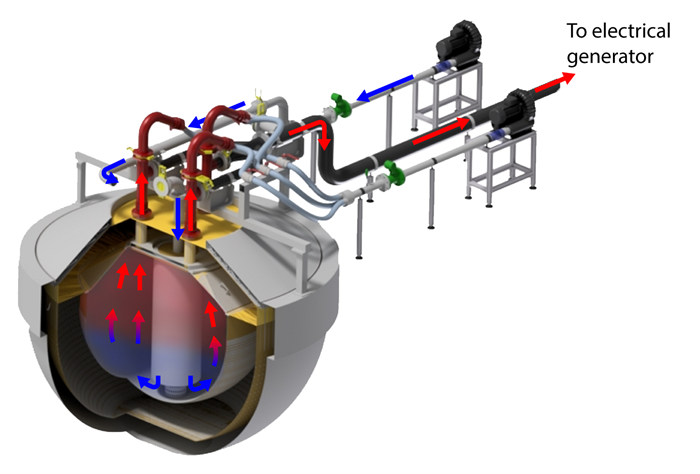The Danish Minister for Higher Education and Science Tommy Ahlers inaugurates an innovative energy storage unit at DTU, showcasing a new concept for energy storage based on hot stones and some very old ideas.
As the energy system shifts from fossil fuels to renewables such as wind and solar, energy storage becomes increasingly important. Indeed, it is not possible to achieve a 100% fossil free economy without robust, affordable solutions for energy storage on a large scale. On Monday, March 18, a new experimental unit for energy storage at DTU Risø Campus was inaugurated by the Danish Minister for Higher Education and Science Tommy Ahlers.
The concept is deceptively simple: When the demand for electricity is lower than wind power production, e.g. on a very windy day, electricity is used to heat up air which is blown through a bed of stones, heating them in the process. When production at a later time is low and demand high, cold air is blown through the hot bed and the exiting hot air used for power generation in a turbine. The unit has been developed in a project led by the Danish utility SEAS-NVE with DTU Energy and other partners.
The minister and the other guests were welcomed by university director Claus Nielsen who emphasized the central importance of novel sustainable energy technologies, not only to DTU but to Danish society and the world at large. We need to come up with new solutions quickly. As Claus Nielsen put it in the words of the American writer and futurist Alex Steffens: “Winning slowly is basically the same as losing outright [...] trying to achieve climate action by doing the same things, the same old ways, means defeat. It guarantees defeat.”
In his speech Tommy Ahlers expressed similar sentiments when he stressed that politicians' talk is not enough – we need to make things happen. And he thought that the present project, with universities, industry and utilities coming together to develop a new solution for energy storage, was an excellent example of the kind of solutions that are needed. On a lighter note, he also took the opportunity to share his own boy-scout related experiences with hot stones. And then it was time for him to press the button starting the storage unit.
"We can already see a promising increase in efficiency"
Associate Professor Kurt Engelbrecht
Using hot stones to store heat is of course an old idea. In recent years, the Danish inventor and honorary professor at DTU Henrik Stiesdal has been instrumental in putting it on the agenda as a relevant energy storage solution.
While the basic concept is simple, if you want to use it for large scale energy storage things start to become a bit more complicated. You need to design the unit such that losses are minimized, both internally in the unit and when you heat exchange with air blown through it either to store or extract heat. A key insight is that you do not want the stones to be all at the same temperature – by maintaining a temperature gradient across the unit, it becomes much more efficient to transfer heat to and from the device.
After building a first prototype, a small scale rock bed with horizontal airflow, the DTU Energy researchers realised that internal air movement due to bouyancy forces degraded storage efficiency. Coupled with extensive modelling, this led to the present design where air flows vertically through a hemisphere filled with rocks. Associate professor Kurt Engelbrecht states: “We have just started testing and already we can see a promising increase in efficiency”. In the coming months the project partners will test the unit extensively. They hope that the results will be sufficiently good to justify upscaling the solution.
